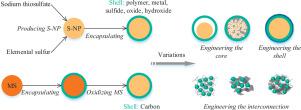Energy Storage Materials ( IF 18.9 ) Pub Date : 2020-09-17 , DOI: 10.1016/j.ensm.2020.09.005 Shiqi Li , Zhaoyang Fan

|
Core-shell structured sulfur composite nanoparticles (NPs) and their various derivatives have been widely investigated as a promising cathode material for Li-S batteries (LSBs) thanks to their unique features in suppressing the lithium polysulfides shuttle effect, accommodating the sulfur electrode volume change, and providing abundant electrochemically active sites. The commonly used infiltration strategy falls short in producing a near ideal core-shell structure. Accordingly, the strategy of encapsulation, in which the prefabricated sulfur or sulfur precursor nanocore is encapsulated by a subsequently formed host shell has attracted broad interest, and this technique has significantly accelerated the LSB development. To advance the state of the art in producing encapsulated sulfur NPs, it becomes necessary to systematically survey the past relevant works and sum up research gaps. This review first takes an excursion to the infiltration strategy to highlight its limitations, followed by surveys on studies of synthesizing sulfur NPs, encapsulating sulfur NPs, and producing encapsulated sulfur NPs from metal sulfides. The strengths and weaknesses of each method, the resulted NPs, their electrochemical properties and the associated LSB performances are particularly emphasized. The rationales to design and the results of applying structural derivatives of the conventional core-shell configuration are then assessed. The encapsulated sulfur NPs applied in aqueous batteries are also discussed. This comprehensive review on sulfur encapsulation is concluded by a summary on further challenges and opportunities as well as our perspectives on possible future research directions, towards fundamental understanding and practical development of encapsulated sulfur NP-based LSB technology.
中文翻译:

锂硫电池中硫颗粒的包裹方法综述
核-壳结构的硫复合纳米颗粒(NPs)及其各种衍生物由于其在抑制多硫化锂穿梭效应,适应硫电极体积变化方面的独特功能而被广泛研究为有前景的Li-S电池(LSBs)正极材料。 ,并提供丰富的电化学活性位。常用的渗透策略不足以产生接近理想的核-壳结构。因此,其中将预制的硫或硫前体纳米核由随后形成的主体壳封装的封装策略引起了广泛的兴趣,并且该技术极大地促进了LSB的发展。为了提高生产封装硫NP的技术水平,有必要对过去的相关工作进行系统的调查并总结研究差距。这篇综述首先介绍了渗透策略,以突出其局限性,然后进行了有关合成硫NP,封装硫NP和从金属硫化物生产封装的硫NP的研究的调查。特别强调每种方法的优缺点,所得的NP,它们的电化学性能以及相关的LSB性能。然后评估设计的原理和应用常规核-壳结构的结构衍生物的结果。还讨论了应用于水性电池的封装硫NP。











































 京公网安备 11010802027423号
京公网安备 11010802027423号